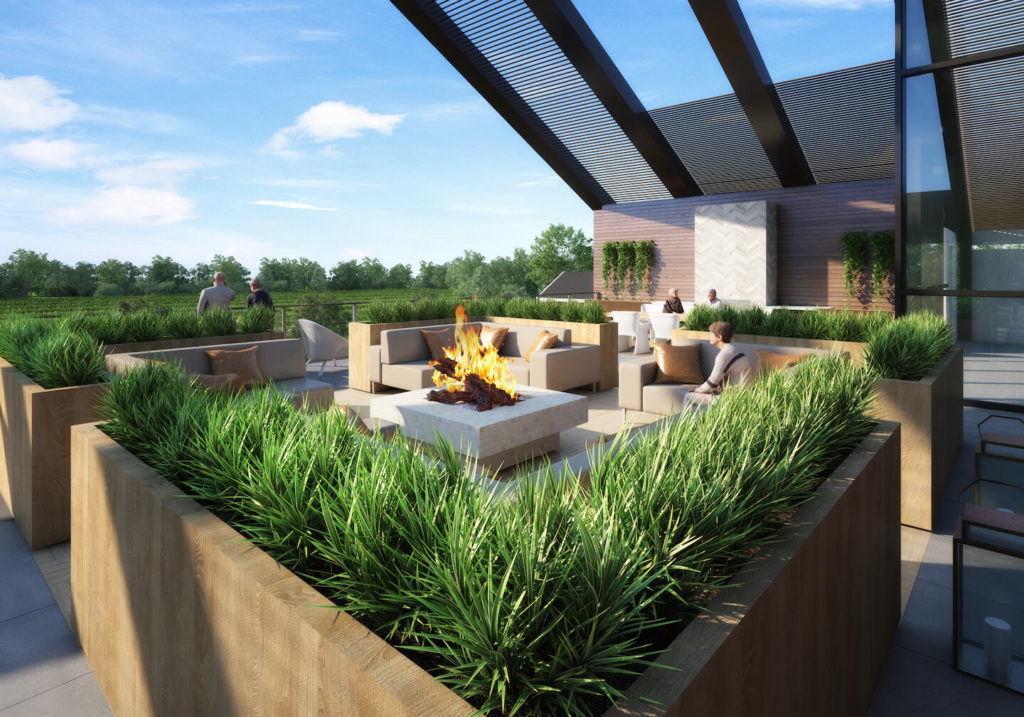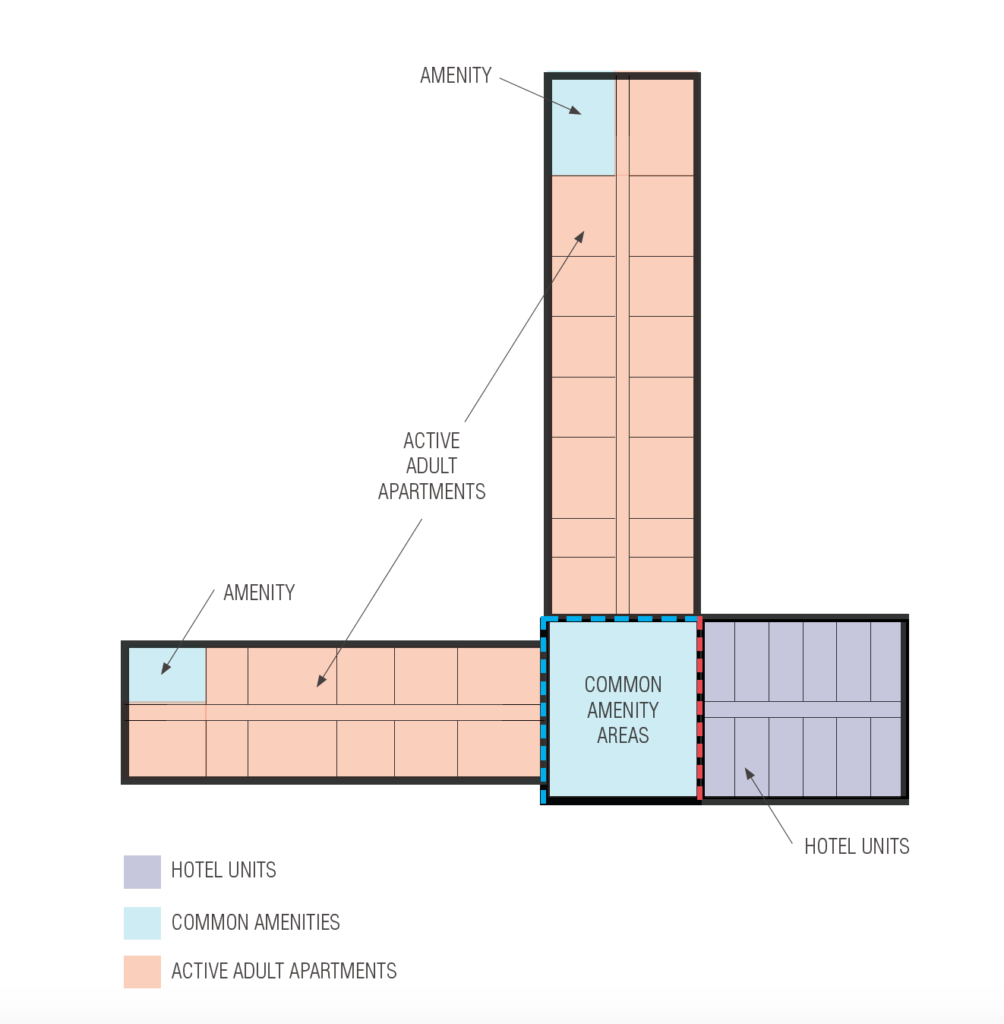
Over the past decade, we’ve seen a near total transformation in expectations — and, consequently, design — for senior living communities. The baby boomer generation, now aged 57 to 76, is demanding something different from the next phase of their lives than what their parents or grandparents experienced.
ULI studies show that adults on the cusp of retirement today are looking for amenity-rich environments. They want robust services, diverse activities and the ability to get around easily. They are not content with going to the same dining room every day, eating the same food, staying in the same limited spaces. The generation responsible for the active adult community design as we know it is determined to live to the fullest in the later stages of life.
As architects and designers who specialize in this space, OZ Architecture is deeply engaged in the process of examining the way baby boomers are living and the way they want to live as they move through the next phases of their lives, and in translating those desires into more thoughtful, exciting community design.

Through this research, four key areas have emerged as opportunities to turn the active adult into the connected, engaged and fulfilled activated adult. By exploring how design for communities for aging adults can better address those four key areas — travel, family/friends/socializing, food experience and health and wellness — developers and operators have an opportunity to better differentiate their communities and ultimately support a better quality of life for residents at any stage of life.
Facilitating travel for older adults
In this first article, we’ll dive into the ways that design of communities can better address the travel needs of aging adults — both their continued passion for adventure and exploration in later stages of life as well as their desire to host loved ones in their own home community.
Baby boomers spent an estimated $157 billion on travel in 2019, taking an average of four to five leisure trips per year. Although COVID-19 put those trips on pause, data suggest that fully 82% plan to take five or more trips this year. This demand for travel provides an opportunity for senior living communities to incorporate travel experiences into their programming.
Designating a unit or two for a hoteling concept isn’t new in the design of communities. Creating a small hospitality wing, however — a cluster of 12 hospitality units, for example — would provide operators with the flexibility to offer tiered options for short-term rental, allowing residents to get away for a while or bring loved ones closer to them.
Creating a home away from home
What if being a part of a community provided perks similar to a time share, but instead of having to adjust to the unknown at your destination, you knew the units would feel familiar and support your needs?
Right now, we’re working with several clients to envision concepts that support national and even international travel for residents. Through this model, a chain of communities would act as a network, and as members, residents could enjoy reciprocal stays in new locations.
In the highest tier of membership, the experience would include use of the hotel unit for one or more nights, plus full access to the community and all amenities and activities. This model could be useful for a prospective resident who wants to stay to try out the community before moving in, or for a resident to travel to a sister community in another location. Residents could fulfill their desires for adventure and new experiences with rooms that offer the comforts of home.
Supporting family and social connections
One of the more challenging aspects of downsizing into an aging adult community for many residents is the loss of the ability to host family and friends. In a traditional model, residents simply don’t have the space within their own homes, requiring extra planning and logistics to sort out a solution that will accommodate all generations. Using the hospitality model, operators can ease the stress and allow families to host their loved ones in their own community. Designing for such a community is all about optimizing quality of life, and facilitating time spent with loved ones is key to that effort.

In the flexible tiered system, the hospitality wing could support a variety of guest experiences and a different level of access to the property, depending on needs.
With a recent project study in Silverthorne, CO, we worked with an operator on a mini hotel model that embraced a range of potential guests. The three-star stay base level was geared toward the traveler who intends to be out and about most the stay; this person might just need a comfortable room to retreat to after a long day of activity. This guest wouldn’t have access to the majority of amenities on the property. A three-star stay might be perfect for a young family visiting a relative or a retired couple looking to ski without the need a full suite of onsite amenities.
The amenity access expanded with four-star and five-star tier, with price points reflective of the accommodation.
The four-star experience was designed for a guest who might plan to stay on the premises a bit more, with greater hospitality options. This option provided guests the luxury of top-notch lodging accommodations and the ability to entertain guests, but maybe not full access to the entire property and activity portfolio. This kind of traveler might be interested in the four-star tier because of plans to venture out from time to time for more offsite experiences to supplement the stay. This type of stay also be perfect for adult children and grandchildren coming to visit their retired relatives.
The five-star accommodation was more of the all-inclusive model, providing guests with full access to amenities and services. This level was developed to satisfy the kind of traveler looking for minimal planning responsibilities; this person just wants to sit back, relax and spend time with loved ones. This level of stay also could be useful for prospective residents who want to stay to try out the community before moving in, or, as described in the preceding section, for the resident of a sister community in another location to come enjoy a different experience with the same familiar framework.
Design approach and implementation
For operators, there are some key considerations for including a hospitality wing.
Financially, the inclusion of these units has to pencil out, of course. The most substantial cost comes from the initial construction. Once built, the units only need to be serviced if they are occupied. Because communities already have housekeeping staff, the ongoing upkeep is relatively minimal. The concept is easier to integrate the lower the quantity of hotel units. In general, we see around one hospitality unit per 100 resident units when this concept is used, although this ratio could be smaller, depending on the operator’s goals for the units. As an added potential benefit, hospitality units can house staff during weather or pandemic emergencies.
To provide the flexibility to shift, should the need for more resident units outweigh the need for hospitality units, the design should share many of the characteristics of a typical unit. Key design differences, such as accessibility and a kitchen for full autonomy, can be inserted into the design to create a more hospitality-driven experience.
Finally, the success of the concept will rely on smart marketing and communication about the capabilities to residents, potential residents and even broader to potential tourists and visitors, depending on the location of the community.
The more we see operators embracing a future for aging adults that turns them into activated adults, the more concepts like this one will become the standard. When residents are able to sustain their passions, when they’re able to travel with the security of a familiar place to land, when they can host friends and family on their home turf, they enjoy a better quality of life. They’re happier, longer. And that’s the greatest gift a thoughtful activated adult community design can provide.
Jami Mohlenkamp is principal at Denver-based OZ Architecture.
The opinions expressed in each McKnight’s Senior Living guest column are those of the author and are not necessarily those of McKnight’s Senior Living.
Have a column idea? See our submission guidelines here.


